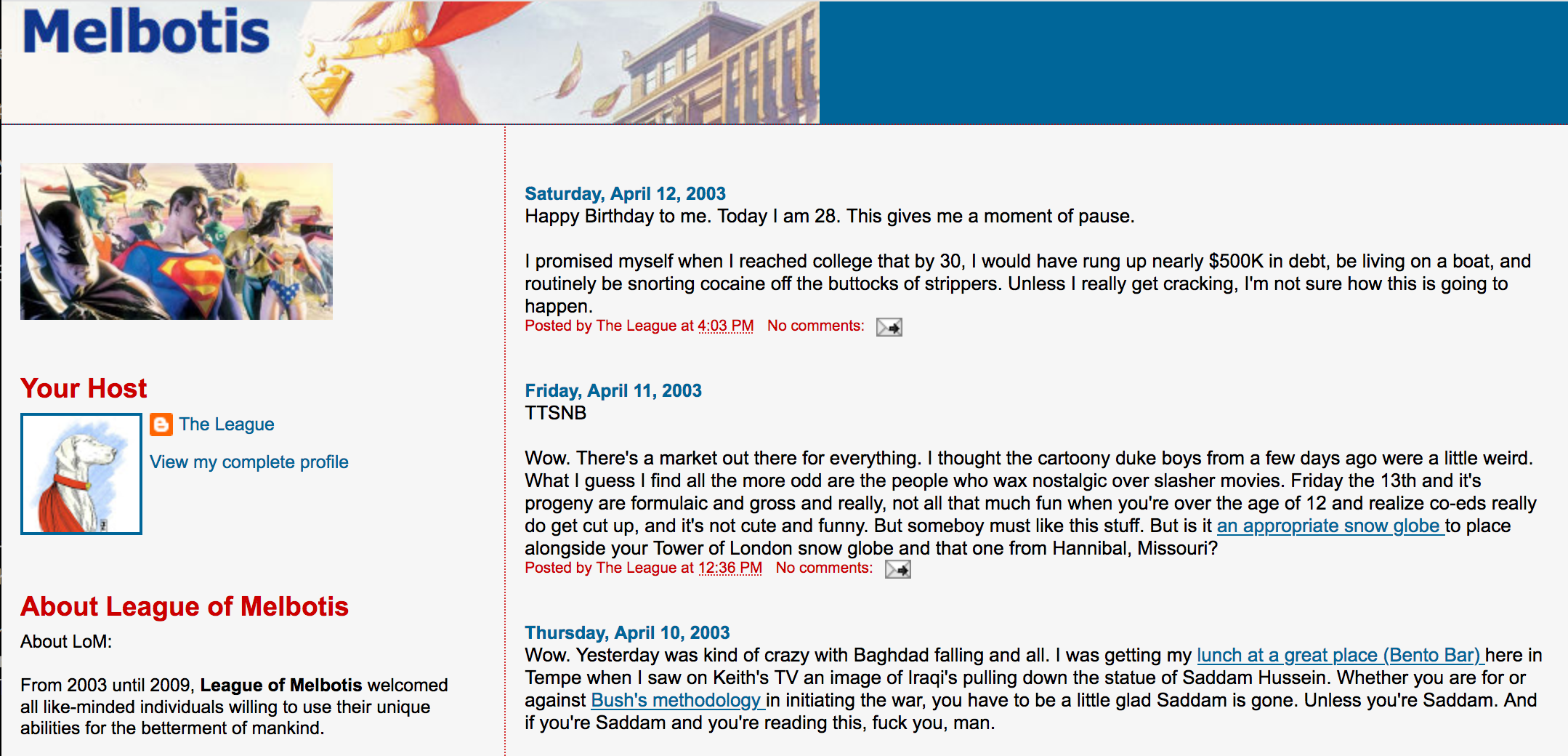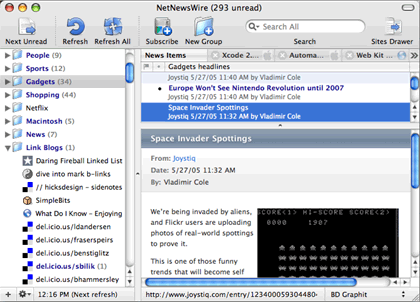POSTS
The Social Media That Should Have Been
BlogPosted to Facebook as Farewell
As I prepare to log out one final time, I’d like to tell you about how I wish social media would have gone. It didn’t go this way. Greed and control and perverse incentives got in the way. I’ll tell you how it was in the late 90’s &emdash; how it was small, quaint, and good &emdash; and how it turned into the blighted, “alternative facts” hellscape of today.
The Bulletin-Board System (BBS) Influence

A lot of my beliefs about how human-to-human networked communication should work were fueled by my life on bulletin board systems (BBS) in the late 90’s. Many now are too young to imagine a world without the internet in their pocket, but, back then, we’d use a phone to tell our home computer how to talk to another computer (“the BBS”) over a land phone line via a hardware device known as a modem.
These BBS computers were usually the second computer in the house. Back then, it was actually pretty rare for a house to have more than one system, so many of these machines’ owners were early adopters, geeks, or hippies — or some intersection. The owners, the system operators, or “SysOps,” were generally doing this out of a hobby, a love of sociability, or loneliness. In exchange for the hardware cost and the second phone-line fee, visitors to their machines were appreciative and thankful for the service the SysOps provided. Every now and again a SysOp might hop into chat with you and thank you for stopping by. It was, in a word, civil.
On BBS’ we were gracious and thankful because we weren’t owed anything. Like someone giving you a lemonade on a hot day, you were thankful, mannerly, and polite. Otherwise you were shunned and that was that.
What was there once your computer got “there?” Well, you could play little games (called “doors”) on the host machine against other visitors. Most of the games were turn based because the system couldn’t support two calls at the same time. So you’d get your five (or so) moves in a trading empires game, or a trivia game, etc. You’d see your status move up the leaderboard and then you’d close the “door.”
You could leave “private” messages to other visitors. Or you could participate in the topic-driven message rooms which were like USENET newsgroups for the less-technical and were a precursor to web forums.
Lastly, many boards offered files for transfer: static images, images, or zipfile components of games that you could install on your computer. For example, before their massively successful games like Doom, id software distributed their opening game changing “Castle Wolfenstein” via BBS distribution, in fact.
After some minutes, we’d log out so that the other computer’s phone line could be freed for another community member. We thought of the other guy and the health and welfare of the shared system.
This social behavior enforced a few key tenets that existed in internet culture from ~1970-2000.
- You “go” to multiple places and this is OK.
- Different places have different “character.” Some are for art, some are for sports. That’s OK. It’s fun to visit different ones — like restaurants
- The news day at a given BBS is slow. Walk away when you’re done.
- “Where” you “go” is remembered by you and, per #1, it’s a list. Therefore you have to keep the list in a program you own
The Rise of the Web

While the web was in its process of flourishing (~1995-2000), this paradigm largely held. The key change in this era is that the message board functionality broke out from the BBS and became the web site. Additionally, the private message function collapsed into one universal inbox, the email address.
The assumptions changed slightly:
- You “go” to multiple places and this is OK.
- Different
BBS’web sites have different “characters.” Some are for art, some are for sports, like restaurants - The news day is slow. Walk away when you’re done.
- “Where” you “go” is remembered by you and, per #1, it’s a list. Therefore you have to keep list state local to the client computer (e.g. a bookmarks file)
By in large, things were pretty good. If anything it felt like we made BBS' available across the world without long-distance phone call fees.
Early Monetization Model
Early monetization of email followed the utility model: for a monthly fee you had a certain guarantee of service quality and a quota. As the web grew to be larger destination on the internet, Web sites were too unproven to demand a fee and, as a result, adopted a model borrowed from newspapers or billboards: you can rent space on our digital canvas for ad impressions.[1][#fn-1]
And herein lay the seed of destruction. While a BBS had always been about a benevolent, volunteer, communitarian endeavor, monetization started to drive the “what can I get” and “what will you give” implicit dialogue between the visitor and the site. As ever users will drive to get as much as they can for free and, facing an ungenerous “foe,” the sites began to look for unwittingly-given payoff from the “foes” that they could use to justify or remedy their operational loss.
Providers and consumers became frenemies.
Eventually providers started to see the users of the site less as visitors or guests, but rather as, en masse, an exploitable resource. Suddenly it appeared more profitable to undermine some of our guiding principles and move towards a maximally-profitable-focused end state. The SysOps no longer had aligned incentives to the users.
You “go” to multiple places and this is OK.Keep eyeballs on our properties. Encourage others to abandon their properties to join ours. Hinder inter-property communication. Enforce tribalism. The more data signals we gather, the more valuable the sale of our data insights to third parties.Different BBS’ web sites have different “character.” Some are for art, some are for sports, like restaurantsProvide a one-stop shop. Clone any feature a competitor offer as quickly as possible.The news day is slow. Walk away when you’re done.Always generate content. Even when there is no content, rehash rehashes to keep something new bubbling all the time. Incentivizeuserssharecroppers to generate content to keep other sharecroppers engaged.“Where” you “go” is remembered by you and, per #1, it’s a list. Therefore you have to keep list state local to the client computer (e.g. a bookmarks file)Go nowhere else, we should mediate all forms of interaction.
If it sounds like today, it is. I call this the “walled garden” end state. We are at the end of this demon seed’s growth as I write this.
While the full, robust execution of this ethos was clearly discernible in 2000, it wasn’t really actionable due to technology limitations. Time and engineering has surmounted these limitations in the intervening years. Nevertheless, 2000-2005 marks the beginning of the march to the fractured reality that we live in in 2021.
At the beginning of that damnable dawn though, the opening technology products felt like advances for good. For around five years, the advances unlocked a lovely golden era. The social media age.
“Web 2.0”: pre-Social-Media-Social-Media Golden Era

As various sources sought to create more content as part of the wrongheaded march to the walled garden, a host of new technology came to their aid: cheaper servers, free server license costs, innovations in browser and the JavaScript language, and content management systems. Software like PHP made blogging platforms like Moveable Type, Blogspot, Blogger, and Wordpress possible. Moore’s law drove down the cost of server time. Google was indexing better than any search engine we’d seen. And then suddenly the light bulb went off:
As with BBS’, humans love community and belonging more than all else. Encourage community creation so that there’s always something new, constantly tease members with the promise of new things and they’ll come back. Don’t be media like television, add community and belonging, create “social media.” Use these new nascent tools to make this “social media” possible.
In this era, we re-delivered the BBS message board experience as a distributed series of topic boards (or, “blogs”) that could be confederated, by the user at home, into the community that fit their personality just like we’d done in the modems-and-BBS era. Again:
- We’d “go” to multiple places and this is OK.
- Different places have different “character.” Some are for art, some are for sports, like restaurants
- The news day is slow. Walk away when you’re done.
- “Where” we’d “go” is _remembered by our computers and, per #1, it’s a list. Therefore, you have to keep list state local to the client computer
Later during this era, syndication technology (RSS) made it possible to update practice #1, we stopped having to “go” and could instead federate many sites into a series of feeds with tools like NetNewsWire:

Appearance of Net Newswire in the early 21st century
Google also offered Google Reader, a web based RSS feed reader.
Eventually, a small UI trick was enabled in many of the reader products: all of the disparate feeds could be inter-leaved to create one feed. It was such a powerful idea that even to this day Facebook, Twitter, Instagram, as well as the departed Myspace or Friendster all used the “unified feed” as their main arena.
The federated feed was email or a podcast aggregator for the web. It was wonderful. It had few ads and it revealed relatively little sellable data about the user. I would call this model the “distributed feed” model. And, obviously, the whip hands behind the walled garden could not let it stand.
Capitalism
Through the early 2000’s, those who chased the capital extraction opportunities of the walled garden continued to use technological innovation to bring the formerly-technically-infeasible dream of the walled garden into reality. Friendster tried to lock up friendship and failed, MySpace took another stab at it, and Google took a stab as well. It was Facebook, though, who got all the right pieces together.
They created a feed of your information sources (whom they called “friends”), &emdash; provided your sources were also in the walled garden. As bait, they hung out relationship status, games, thinly-veiled gambling simulacra, photos, etc. to seed the population required to initialize a mass sign-up. In chasing this they would create network effect &emdash; a sustainable competitive advantage &emdash; and hobble any would-be competitors.
The Monetization Play (~2005-2010)
None of this will come as any surprise for anyone who saw “The Social Network,” but the next moves were to:
- Add more bodies to the pyre of Facebook’s walled garden (Facebook Authentication, more friends, email address book harvesting, quizzes, etc.)
- Keep eyeballs engaged (Farmville, Zynga, Chat, Alerts, Mobile versions, etc.)
- Begin the deploying the research around machine learning and data science with established techniques of “market segment analysis."[2][fn-2]
Along the way, Facebook had made a vital insight. Selling ads to the eyeballs of the chumps was kids play; selling the insights into the chumps' demographics, behavior, and interests was a license to print money. In short, all those bodies in the walled garden, when correctly indexed, investigated, tagged, sorted, collated, and sectioned was pure fucking gold.[3][fn-3]

Cocaine snorting scene from ‘Scarface’
The Monetization Squeeze (~2010-2016)
With every day, Facebook engineered more ways to get more advertising signals
about their stable of prostitutes users.
- Hook grandma on the FOMO of missing baby pictures
- Hook the horny on the prospect of the available
- Hook the lonely on the prospect of community
- Show the Southern grandmas with a college degrees this ad
- Show emphysemiac Rust Belters test ads until they find the one that prompts a re-share
For advertisers, it was the best game in town next to a perfect statistical sample of a high-value population. And Facebook was the only broker.
The only trouble with capitalism, as Marx noted, is that it must continue to devour new adjacencies in order to keep growing. And with more users than live in many countries of the world by population, Facebook was topping out. Against upstarts like Instagram, Snapchat, and TikTok they were looking creaky and vulnerable.
But by now the data science and the internal statistical work had started years earlier something very interesting. By appealing to the Dark Side, they could drive engagement.
- Find a quiet Vermont liberal… (keep in mind, all the users are tagged and sectioned with these sentiment affiliation scores)
- who knew a twice-divorced, free-marketer from an investing class
- and share his thumbs up for Donald Trump’s “Grab ’em by the pussy” video
- knowing she was 89% likely to post in disgust
- and then show her a series of lefty-confirming “The Atlantic” ads
- and on his click-through from a “notification” to this post, show him:
- PAC ads for elect Trump 2016
- A Trump / Pence t-shirt
- A post from a 94% sentiment match within his network that he is 90% likely to re-share
With dozens of diabolical delineations, Facebook started playing its users like fiddles in order to help grow its wealth. The only down side is that it created echo chambers of dangerous disinformation. But profit, right?
But then the next Marxian adjacency it needed to cannibalize came into view the
commonweal of the democracy. They could but should they? #yolo, they did.
It’s not that Facebook set out to break democracy exactly, it’s that their data and research algorithms yielded strategies that supported their capitalistic goal while eviscerating democracy and our republic. If anything, the algorithms produced the perfect answer: given tribal, reactionary, impatient, hasty hominids, here’s how to keep them interacting more and more in a nautilus shell of recursive rage and (ka-ching) “engagement.”
…And all the while they called the connections that made it possible “friendship.”
The Modern Moment
And here we are at the present. We have a world so deranged by disinformation that partisans of abject falsehoods behave as if their right to be fooled is something to be cherished. They prosecute federal crimes and capital offenses because they’ve been brainwashed like cult members.
Meanwhile, we have venal tech leaders offering broth-thin excuses and promises to do better. I hope it’s just the panic of those who realize that their gravy train’s days might be numbered.
The Future
As I think about the past, I have a vision for the future. I’d like to go back to a software experience where the tool:
- Is largely text based, like the BBS. This will keep load times fast and ads few-to-none
- The software visits multiple places, like the Golden Era, and fills your “web inbox” with information.
- The software gives you one inbox or “feed” if you like
- Different places have different “character.” Some are for art, some are for sports. That’s OK. It’s fun to visit different ones, like restaurants. Hopefully some of those sources are different from your default mode and they challenge you to be better. It would look something like most peoples podcast app today: some true crime, some news, some radio drama; news from the left, commentary from the right, hot new music
- The news day can be marked read at some point. Walk away when you’re done.
- “Where” you “go” is remembered by you and, per #1, it’s a list. Therefore you have to keep the list in a program you own. Clever caching and syncing keeps your phone and computers synchronized
- You are respected as a guest, not gamed, and not prodded by stimuli in order to be a signal for a conjecture.
I want something that looks like BBS’, feels like BBS’, has the cordiality of BBS’, and covers the whole world. I hope the future looks more like the past.
Footnotes
- It would be left as a product coup to realize that if email could be web-ified it could be monetized (first by Hotmail; then, Yahoo Mail, and ultimately Gmail).
- This would prove to be the demonic pairing that would create the fractured reality in which disinformation campaigns like “Plandemic,” “QAnon,” and anti-vaxxer groups would thrive
- <a name=“fn-3” I write of Facebook here, but Alphabet’s YouTube and Twitter are similar in most substantial ways